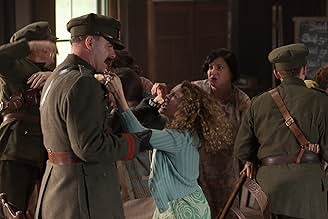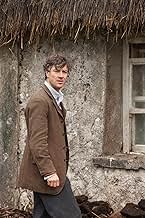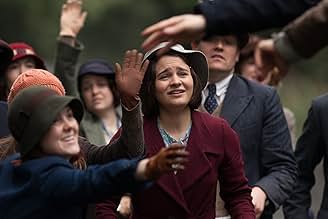Durante la Depressione, Jimmy Gralton torna a casa in Irlanda dopo dieci anni d'esilio in America e vedendo la povertà e l'oppressione, l'attivista che è in lui si risveglia e vuole riaprire... Leggi tuttoDurante la Depressione, Jimmy Gralton torna a casa in Irlanda dopo dieci anni d'esilio in America e vedendo la povertà e l'oppressione, l'attivista che è in lui si risveglia e vuole riaprire la sala da ballo che lo portò alla deportazione.Durante la Depressione, Jimmy Gralton torna a casa in Irlanda dopo dieci anni d'esilio in America e vedendo la povertà e l'oppressione, l'attivista che è in lui si risveglia e vuole riaprire la sala da ballo che lo portò alla deportazione.
- Premi
- 2 vittorie e 3 candidature totali
Recensioni in evidenza
It deals with the very specific conflict between those who opposed the Treaty, those who supported it and the dominating Catholic Church when one, Jimmy Gralton, returns from 10 years exile in America and reopens a community hall that was the source of all his trouble in the first place, against the express wishes of 'Holy Mother Church' and those who backed it.
As scripted by Paul Laverty it is, of course, a deeply political film but Loach is the most humanist of political film-makers; consequently it is also a deeply moving (and, at times, very funny) picture. At its centre is a magnificent performance from Barry Ward as Gralton and he is backed beautifully by Jim Norton and Andrew Scott representing the clergy as well as a host of wonderfully naturalistic Irish actors, some professional, some not. Loach may now be in this seventies but this feels as fresh and as relevant as anything he did fifty years ago. I think it's the equal to both "Land and Freedom" and "The Wind that Shakes the Barley".
How did he do that? He set up a dance hall, how scandalous. Whilst by and large the locals embraced it and it provided them with a focal point there was opposition. The church led the way, and some local conservatives followed. By branding them as communists provided their arguments with some supposed gravity. What went on in that hall was open for all to see, yet it met with fierce opposition.
The film puts the two worlds into focus. One view is that change is reprehensible, things ought to stay as they are. The opposing view wants change, people to be free from oppression. The newcomer brought some new ideologies as well as lots of controversy.
Both sides are unchangeable in their positions, no one is prepared to backtrack and a clash is unavoidable. Can the idealist modernist challenge the ultra powerful church orthodoxy?
A mighty tale about old and new in the battlefield of ideas.
What, indeed, could be wrong with opening a dance hall and cultural center? Well in the thirties Ireland was recovering from years of bloody conflict, first the war for independence, followed by more years of civil war. Father Sheridan argues that now is the time for reconciliation, not for political agitation, and what he sees as communist propaganda. It is time for being Irish together, for listening to Irish music rather than "alien Jazz from deepest Africa".
Of course the Loach's sympathy (and ours) goes to the yearning of the young people who have no place to go, no prospects, no jobs, and who desperately want to find some joy, relief and self-expression. The movie may be a bit slow at times, but it is deeply moving.
One flaw in the movie is that people assume the struggle between Jimmy and the priest is communism versus the church. But Jimmy was not a communist. Jimmy was a grass-roots liberal who supported his community and occasionally spoke out against the concentration of power. The church represents this concentration of power and the struggle to maintain the concentration of power.
During the 1920's, a large percentage of the world's "Wealth" was tied up in speculative investments. Corrupt politicians sided with the land holders and the "Robber barons". By 1924, economic experts started to announce that unfettered greed would lead to an economic crisis in the USA and Europe. In 1929, the US stock-market crash vaporized much of the world's wealth and centralized power among an even smaller percentage of the population.
The movie includes a lot of history that most people in the US and UK who were born before 1977 already know. However, for most of the world, the Irish history and the extent of the struggle between the rich and poor during those times is new.
This struggle continues today. Instead of hereditary land owners, we have large banks and other institutions that "influence" most of the world's "capitalist" governments. The government favors for corporations and privatization of government services that starting in the late 1970's continues to this day and is responsible for the depression of 2008.
Without government support for those who were thrown into poverty, the 2008 depression would have been as bad as the 1929 depression. I think the writers were trying to remind us about the consequences of unfettered greed.
Partially filmed in the village of Drumsna, a village only a few kilometers from Gralton's birthplace in Effrinagh, the film begins in 1932 with Jimmy's return to County Leitrim after having lived in New York for ten years. After showing historical footage of New York during the 1930s, particularly its poverty and unemployment during the great depression, we learn that Jimmy's brother has recently died and he is coming home to support his mother (Aileen Henry) in running the family farm. In a flashback to ten years ago, Jimmy is shown pleading with his then girlfriend Oonagh (Simone Kirby, "Season of the Witch") to go to New York with him, but she prefers to remain in Ireland. When he returns, he finds her married with two children, though they obviously still have feelings for each other.
When he responds "Same as ever" to her question about how he is, she tells him that "Nobody's the same after 10 years away." Now named after Patrick Pearse and James Connolly, two martyrs of the 1916 Easter uprising against British rule,Jimmy restores the boarded-up community hall that had been closed by the Catholic Church ten years earlier, stocking it with a wind-up Victrola and jazz records he brought from New York. Once again, the hall becomes a gathering place for workers and farmers and a thorn in the side of the Church. Dances are picketed and classes disrupted, but Jimmy refuses to bend. Fearful of stoking community activism, Father Sheridan (Jim Norton, "Extremely Loud and Incredibly Close") stirs up his congregation by playing the Communist card and by warning his flock about the debasement of the country's morals.
"What is this obsession with pleasure?!" he demands, and asks "Is it Christ, or is it Gralton?" Railing against "the Los Angelization of our culture," the fearful pastor says that the hall has become a place where "the sins of jazz music and the rhythms from darkest Africa with pelvic thrusts may poison the minds," and reads aloud the names of those who went to the hall the previous night. Fortunately for Gralton, neither Karl Marx nor Joseph Stalin could make it. Repercussions do not take long to occur. IRA activist Commander Dennis O'Keefe (Brian F. O'Byrne, "Queen and Country") is shown whipping his daughter because hers was one of the names read aloud, shots are fired into the hall during a dance, and the hall is set on fire and burned to the ground on Christmas Eve, 1932.
The best scenes in the film are Gralton's one-on-one conversations with Father Sheridan in which he reflects on the father's outward display of hatred towards those who are working towards the common good, defying Christ's message to love thy neighbor. While Sheridan is undoubtedly the villain, the intimate talks with Gralton ultimately make a dent in his intransigence and he tells his friends that Jimmy has more courage than any of them and should be treated with respect. Though his hint of transformation is aided by a young priest, Father Seamus (Andrew Scott), it is too little and too late to make a difference to Jimmy who is arrested and, deported to America where he will live out the rest of his life.
Jimmy's Hall, like all of Loach's work, has its heart in the right place. It is well acted and filled with enchanting Irish folk music and high spirits, yet in sacrificing subtlety and nuance to score political points, it fails to come alive with real passion. The film does have an important message that is relevant to us in the present day where the concentration of wealth in a small percentage of the population threatens our democratic heritage, yet the characters are more cuddly than fiery, more one-dimensional symbols than fully realized human beings. In spite of the timeliness of the subject matter, Jimmy's Hall does not stir the blood.
Lo sapevi?
- QuizThe real Jimmy Gralton was the only Irishman ever deported from Ireland after Irish Independence. After the release of the film, a 2015 campaign (including an online petition) was started with the aim to rescind the deportation order and extend an official apology to his family. In 2016, this resulted in the President of Ireland stating the only deportation of an Irishman from Ireland was "wrong and indefensible." He unveiled a Gralton memorial at Effrinagh outside Carrick-on-Shannon, on the site where the hall once stood. The stone edifice, which tells Gralton's life story as a labor campaigner, was partially funded by the trade union movement.
- BlooperTobacco consumption (cigarettes, snuff and pipes) was extremely widespread at the time, yet none of the characters are seen to smoke, even at raucous social occasions.
- Citazioni
James Gralton: We need to take control of our lives again. Work for need, not for greed. And not just to survive like a dog, but to live. And to celebrate. And to dance, to sing, as free human beings.
- Curiosità sui creditiAt the end of a long list of people and organizations under the heading "Thank You" in the end credits, Dixie the horse, Cabundie the donkey, and Homer the three-legged dog are mentioned.
- ConnessioniFeatured in La noche de...: Jimmy's Hall (2017)
- Colonne sonoreSugar Foot Strut
Written by Harry Myers, Billie Pierce, Charles Schwab, Georges Matis
Used by kind permission of Carlin Music Corp.
Performed by Louis Armstrong & His Savoy Ballroom Five
courtesy of Sony Music Entertainment Inc.
I più visti
- How long is Jimmy's Hall?Powered by Alexa
Dettagli
- Data di uscita
- Paesi di origine
- Siti ufficiali
- Lingue
- Celebre anche come
- Jimmy's Hall
- Luoghi delle riprese
- Killanummery, Co. Leitrim, Irlanda(Jimmy's Hall and surroundings)
- Aziende produttrici
- Vedi altri crediti dell’azienda su IMDbPro
Botteghino
- Budget
- 6.911.962 € (previsto)
- Lordo Stati Uniti e Canada
- 560.592 USD
- Fine settimana di apertura Stati Uniti e Canada
- 19.881 USD
- 5 lug 2015
- Lordo in tutto il mondo
- 4.825.184 USD
- Tempo di esecuzione1 ora 49 minuti
- Colore
- Mix di suoni
- Proporzioni
- 1.85 : 1
Contribuisci a questa pagina


































